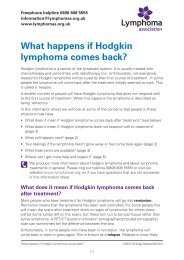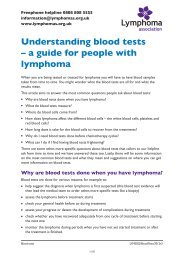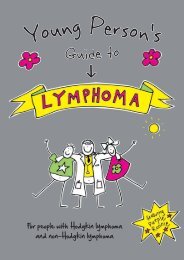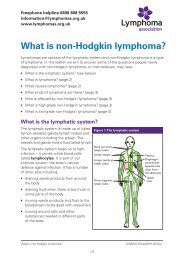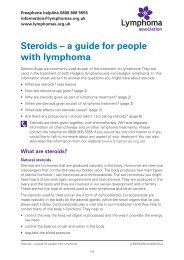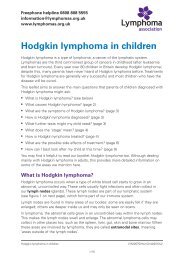Cutaneous T-cell lymphoma - Lymphoma Association
Cutaneous T-cell lymphoma - Lymphoma Association
Cutaneous T-cell lymphoma - Lymphoma Association
You also want an ePaper? Increase the reach of your titles
YUMPU automatically turns print PDFs into web optimized ePapers that Google loves.
In a small proportion of people, raised lumps appear on the skin (tumours). Tumourscan ulcerate and weep and this can be painful (see figure 4, page 4).Figure 5: ErythrodermaIn a very few people the skincan become red, thickenedand sore all over. This is callederythroderma (see figure 5). If thishas happened it is likely that therewill be some <strong>lymphoma</strong> in thelymph nodes too, but mycosisfungoides does not usually involveother internal organs and is rarelyfound in the bone marrow.How is classic mycosis fungoides treated?Mycosis fungoides can be very effectively treated and well controlled, but it has atendency to come back when treatment is stopped. A few people need no treatmentat all at first but a good skincare regime with regular use of moisturisers will help toprevent dryness and irritation. This is all that will be required for some people withstage I disease.If larger areas of skin are affected or the itch is troublesome, mycosis fungoidescan be treated with treatments applied directly to the skin, such as steroid creams,phototherapy with PUVA (a psoralen tablet plus ultraviolet A light) or narrow-band UVB(ultraviolet B light) or topical chemotherapy drugs such as carmustine (BCNU). If tumourshave developed, these can be treated with radiotherapy.If the lymph nodes are involved, if the plaques and tumours are more extensive or ifthe topical treatments are not effective in early-stage disease, a combination of PUVAphototherapy and a drug called interferon alpha (injected just under the skin) or acombination of PUVA phototherapy and a retinoid drug such as bexarotene (Targretin ® )in tablet form might be given. Alternatively, total skin electron beam therapy (TSEBT)might be considered.If mycosis fungoides doesn’t respond to these treatments or if it is at a more advancedstage when it is diagnosed, the following treatments might be considered:● chemotherapy drugs such as methotrexate, chlorambucil, liposomal doxorubicin(Caelyx ® ) or gemcitabine● newer drugs such as the fusion toxin, denileukin diftitox (Ontak ® ) or the histonedeacetylase (HDAC) inhibitor, vorinostat● a combination of chemotherapy drugs (such ‘CHOP’, which is a combination oftenused for people with other types of <strong>lymphoma</strong>).<strong>Cutaneous</strong> T-<strong>cell</strong> <strong>lymphoma</strong>LYM0157/CTCL/2013v311/18



